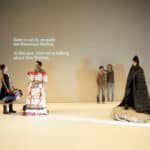Motus. Nella tempesta (2013)
By Enrico Casagrande and Daniela Nicolò
With Silvia Calderoni, Glen Çaçi, Ilenia Caleo, Fortunato Leccese, Paola Stella Minni
Drammaturgy by Daniela Nicolò
Assistant director and translations Nerina Cocchi
Technical direction and sound Andrea Gallo
Moving-head design Alessio Spirli
Shooting and video editing Enrico Casagrande and Daniela Nicolò
Organization and production Elisa Bartolucci and Valentina Zangari
promotion and distribution abroad Lisa Gilardino
Press office Sandra Angelini
A Motus Production, with: Festival TransAmériques – Montréal, Théâtre National de Bretagne – Rennes, Parc de la Villette – Parigi, La Comédie de Reims – Scène d’Europe, Kunstencentrum Vooruit vzw – Gent, La Filature/Scène Nationale – Mulhouse, Festival delle Colline Torinesi – Torino, Associazione Culturale dello Scompiglio – Vorno, Centrale Fies/Drodesera Festival – Dro, L’Arboreto/Teatro Dimora – Mondaino | con il sostegno di ERT (Emilia Romagna Teatro Fondazione), AMAT, La Mama-New York, Provincia di Rimini, Regione Emilia-Romagna, MiBAC
In collaboration with M.A.C.A.O – Milano, Teatro Valle Occupato – Roma, Angelo Mai Occupato – Roma, S.a.L.E. Docks -Venezia motus ringrazia Judith Malina, Voina, Mauro Maggioni, Giulia, Soumya, Lillo, Giulio, Rauff, Pina e tutto il Comitato popolare di lotta per la casa di Roma, Giuliana Sgrena, Med Ali Ltaief (Dalì), Luca Scarlini, Anastudio, Exyzt, Mammafotogramma, Re-Biennale, tutti i partecipanti ai MucchioMisto Workshop
Drawing “Moltitudini” by Marzia Dalfini
First performance 24-27 may 2013, Montrèal (Canada), Place des Arts-Cinquième Salle, FestivalTransAmériques,
Nella tempesta, Motus 2013. Presentation
by Renata Savo
The main theme of the play is undoubtedly The Tempest in its literary interpretations from William Shakespeare to Aimé Césaire. The latter gives Shakespeare’s work a post-colonial slant. But the tempest also takes on another meaning, one exhorted and shouted at the top of their lungs by the Living Theater and its soul Judith Malina: the tempest as “revolution.” “This blanket,” says Silvia Calderoni on stage, “comes from the house of Judith Malina, in NY, we were with her when Hurricane Sandy came … She told us we shouldn’t protect ourselves from storms, but unleash them ….”.
Another main theme, the theater, intended as a place of possibility where one is allowed to imagine and build new relationships; first of all, the relationship between Prospero and Ariel, or that between director and actor. But the theme of the theater overlaps interestingly in this play with the theme of power, already present in Shakespeare. Above all, in Aime Cesaire’s modern version it becomes a pretext to talk about issues such as xenophobia and immigration. The play was modified in keeping with the socio-cultural milieu in which it was staged: in New York, Motus “did a version more linked to the historical reality that was sweeping across America’s cities, with protests over the deaths of young African Americans murdered by the police …”
The situation is that of five actors grappling with Shakespeare’s and Césaire’s Tempest by analyzing its characters and in certain points interpreting their roles, like actors “trying” to translate them on stage using available means. In this sense only some of the aspects related to the aforementioned topics are developed. Time, therefore, is crystallized into a “here and now,” unfolding through a set of actions that create a new outlook on the work, one related to the contemporary world. For this reason, the performance text also gives voice to what is off-stage, projected onto a PVC tarp in the background. Here we see Silvia Calderoni walking the streets of Lampedusa, querying immigrants, asking who, for them, is the boss that governs them, and reiterating the question to theater spectators: a question that creates a potential for reflecting on the conventional power relationship that reigns over the stage, among which the actors who may ask spectators to perform certain actions. To give cohesion to the show, it is not the text but the actors who claim its imaginative creative power, as does Ariel, a spirit yearning to be free from his “director” Prospero.
Documents are published in original language. In case the translation is present, both the original and the translation are published.
Nella tempesta
video-spectacle
Laura Gemini, “Nella tempesta” di Motus: il teatro come utopia realizzabile, «D'ARS», 7 August 2013
Pierfrancesco Giannangeli, Al Festival delle Colline Torinesi si prova a immaginare il futuro, «Hystrio», n. 3, July-September 2013
Simona Cappellini, L'uomo moderno nella macro Tempesta dei Motus, «Krapp's Last Post», November 5, 2013
Viviana Raciti, Trai i rifugi dei Motus Nella Tempesta, «TeatroECritica», 12 April 2014
Valeria Ottolenghi, Magnifici i Motus con Shakespeare - Nella tempesta della vita e della scena, «Gazzetta di Parma», 13 April 2014
Dalila D’Amico, Uno sguardo di battaglia sul presente tra Shakespeare e Aimé Césaire, «retididedalus.it», May 2014
Maria Grazia Gregori, L'isola di Shakespeare diventa la terra d'approdo dei rifugiati, «l'Unità», June 22, 2013
Diego Pizzorno, Daniela Nicolò, Sull'isola utopica di Motus. Intervista a Daniela Nicolò, «LA TEMPESTA», daily of the critical writing workshop by Andrea Porcheddu, 4-5 August 2013
Renata Savo, Sandra Angelini, Motus 008-013: la storia di una svolta, ancora da scrivere – Corrispondenza via e-mail con Sandra Angelini, Teatri del reale nella realtà del teatro: il reality trend in Italia, tesi di laurea, Università degli Studi “La Sapienza” di Roma, Dipartimento di Filosofia, Lettere, Scienze Umanistiche, Studi Orientali, corso di laurea in Spettacolo teatrale, cinematografico, digitale: teorie e tecniche, a. a. 2014-2015, rel. V. Valentini








